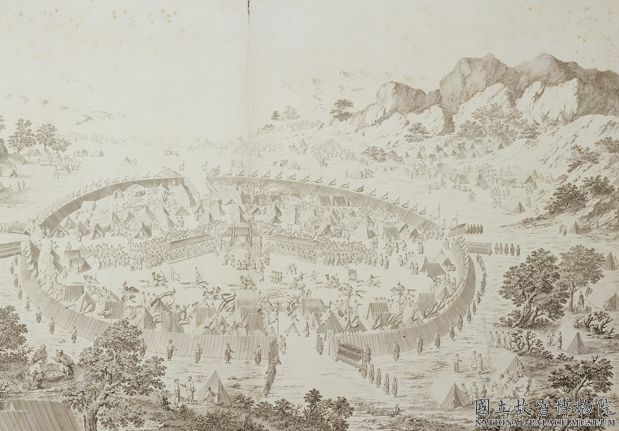[The atlas of Wang’s shoes in Huashan]
The atlas of Huashan, Ming Dynasty, Wang’s shoes, paper, ink or color, 34.5cm in length and 50.5cm in width
This picture reads “Teresau”. According to the title, it is known that this picture was painted by Wang Lu after he visited Mount Hua in the 16th year of Hongwu (1383). The artistic conception of the whole book is either steep, deep, vast, or clear, which fully displays the beautiful scenery and scenic spots of Mount Hua. The author systematically discusses his painting ideas in the Preface to the Huashan Painting. Among them, the view of “learning from nature” and the view of “freehand brushwork in form” of “learning from heart, learning from eyes, and learning from Huashan” have a profound impact on the theory of landscape painting in later generations
Mount Huashan, which overlooks the Yellow River in the north and Tongguan in the east, is towering and towering. It has been listed as one of the five famous mountains since ancient times, and is known as the Western Mountain. Its magnificent scenery has become the subject of praise by poets and painters of all ages
There are 40 picture pages in this volume, and there are 66 self-written notes, postscripts, poems and pictures, which are combined into one volume. The Palace Museum has 29 picture pages, and the rest is in Shanghai Museum. Each scene has exquisite description. As shown in “The Picture of the Peak Above”, the picture is of a precipitous terrain, with the mountains facing each other, and the iron locks hanging down on the steep peak wall, like a silver train hanging in the air. The pedestrians under the cliff look up, deliberately rendering the precipitous situation of “no road on the green wall, no luck in the future” (Han Yushi). The “Top of Canglong Ridge” is surrounded by clouds and mists, and the peaks and peaks are looming. It is a vast and rhythmic atmosphere. The whole picture is mainly in ink, with ochre, cyan and other light colors. The composition is mostly close and middle shot, highlighting the main body and paying attention to the depth of space. The pen is straight and sharp. The rocks are mostly chopped with sharp strokes to show the solid stone quality of Huashan, while the trees are shown with simple strokes as thin and hard as bent milling iron. The painting method is taken from Ma Yuan and Xia Gui of the Southern Song Dynasty and has its own style. This picture is the masterpiece of Wang Lu in his later years, and it is also his only surviving copy
Wang Jiayu’s Coral Net in the Ming Dynasty, Zhu Cunli’s Iron Net Coral, Bian Yongyu’s Collection of Paintings and Calligraphy in Shigutang in the Qing Dynasty, and the owner of Shibaizhai’s Collection of Paintings and Calligraphy in Shibaizhai.
![图片[1]-Wang Wenhua Mountain Atlas-China Archive](https://chinaarchive.net/Ming dynasty/painting/2213[1024].jpg)
![《华山图》册第二开 图片[2]-Wang Wenhua Mountain Atlas-China Archive](https://chinaarchive.net/Ming dynasty/painting/2214[1024].jpg) 《华山图》册第二开
《华山图》册第二开![《华山图》册第三开 图片[3]-Wang Wenhua Mountain Atlas-China Archive](https://chinaarchive.net/Ming dynasty/painting/2215[1024].jpg) 《华山图》册第三开
《华山图》册第三开![《华山图》册第四开 图片[4]-Wang Wenhua Mountain Atlas-China Archive](https://chinaarchive.net/Ming dynasty/painting/2216[1024].jpg) 《华山图》册第四开
《华山图》册第四开![《华山图》册第五开 图片[5]-Wang Wenhua Mountain Atlas-China Archive](https://chinaarchive.net/Ming dynasty/painting/2217[1024].jpg) 《华山图》册第五开
《华山图》册第五开![《华山图》册第六开 图片[6]-Wang Wenhua Mountain Atlas-China Archive](https://chinaarchive.net/Ming dynasty/painting/2218[1024].jpg) 《华山图》册第六开
《华山图》册第六开![《华山图》册第七开 图片[7]-Wang Wenhua Mountain Atlas-China Archive](https://chinaarchive.net/Ming dynasty/painting/2219[1024].jpg) 《华山图》册第七开
《华山图》册第七开![《华山图》册第八开 图片[8]-Wang Wenhua Mountain Atlas-China Archive](https://chinaarchive.net/Ming dynasty/painting/2220[1024].jpg) 《华山图》册第八开
《华山图》册第八开![《华山图》册第九开 图片[9]-Wang Wenhua Mountain Atlas-China Archive](https://chinaarchive.net/Ming dynasty/painting/2221[1024].jpg) 《华山图》册第九开
《华山图》册第九开![《华山图》册第十开 图片[10]-Wang Wenhua Mountain Atlas-China Archive](https://chinaarchive.net/Ming dynasty/painting/2222[1024].jpg) 《华山图》册第十开
《华山图》册第十开![《华山图》册第十一开 图片[11]-Wang Wenhua Mountain Atlas-China Archive](https://chinaarchive.net/Ming dynasty/painting/2223[1024].jpg) 《华山图》册第十一开
《华山图》册第十一开![《华山图》册第十二开 图片[12]-Wang Wenhua Mountain Atlas-China Archive](https://chinaarchive.net/Ming dynasty/painting/2224[1024].jpg) 《华山图》册第十二开
《华山图》册第十二开![《华山图》册第十三开 图片[13]-Wang Wenhua Mountain Atlas-China Archive](https://chinaarchive.net/Ming dynasty/painting/2225[1024].jpg) 《华山图》册第十三开
《华山图》册第十三开![《华山图》册第十四开 图片[14]-Wang Wenhua Mountain Atlas-China Archive](https://chinaarchive.net/Ming dynasty/painting/2226[1024].jpg) 《华山图》册第十四开
《华山图》册第十四开![《华山图》册第十五开 图片[15]-Wang Wenhua Mountain Atlas-China Archive](https://chinaarchive.net/Ming dynasty/painting/2227[1024].jpg) 《华山图》册第十五开
《华山图》册第十五开![《华山图》册第十六开 图片[16]-Wang Wenhua Mountain Atlas-China Archive](https://chinaarchive.net/Ming dynasty/painting/2228[1024].jpg) 《华山图》册第十六开
《华山图》册第十六开![《华山图》册第十七开 图片[17]-Wang Wenhua Mountain Atlas-China Archive](https://chinaarchive.net/Ming dynasty/painting/2229[1024].jpg) 《华山图》册第十七开
《华山图》册第十七开![《华山图》册第十八开 图片[18]-Wang Wenhua Mountain Atlas-China Archive](https://chinaarchive.net/Ming dynasty/painting/2230[1024].jpg) 《华山图》册第十八开
《华山图》册第十八开![《华山图》册第十九开 图片[19]-Wang Wenhua Mountain Atlas-China Archive](https://chinaarchive.net/Ming dynasty/painting/2231[1024].jpg) 《华山图》册第十九开
《华山图》册第十九开![《华山图》册第二十开 图片[20]-Wang Wenhua Mountain Atlas-China Archive](https://chinaarchive.net/Ming dynasty/painting/2232[1024].jpg) 《华山图》册第二十开
《华山图》册第二十开![《华山图》册第二十一开 图片[21]-Wang Wenhua Mountain Atlas-China Archive](https://chinaarchive.net/Ming dynasty/painting/2233[1024].jpg) 《华山图》册第二十一开
《华山图》册第二十一开![《华山图》册第二十二开 图片[22]-Wang Wenhua Mountain Atlas-China Archive](https://chinaarchive.net/Ming dynasty/painting/2234[1024].jpg) 《华山图》册第二十二开
《华山图》册第二十二开![《华山图》册第二十三开 图片[23]-Wang Wenhua Mountain Atlas-China Archive](https://chinaarchive.net/Ming dynasty/painting/2235[1024].jpg) 《华山图》册第二十三开
《华山图》册第二十三开![《华山图》册第二十四开 图片[24]-Wang Wenhua Mountain Atlas-China Archive](https://chinaarchive.net/Ming dynasty/painting/2236[1024].jpg) 《华山图》册第二十四开
《华山图》册第二十四开![《华山图》册第二十五开 图片[25]-Wang Wenhua Mountain Atlas-China Archive](https://chinaarchive.net/Ming dynasty/painting/2237[1024].jpg) 《华山图》册第二十五开
《华山图》册第二十五开![《华山图》册第二十六开 图片[26]-Wang Wenhua Mountain Atlas-China Archive](https://chinaarchive.net/Ming dynasty/painting/2238[1024].jpg) 《华山图》册第二十六开
《华山图》册第二十六开![《华山图》册第二十七开 图片[27]-Wang Wenhua Mountain Atlas-China Archive](https://chinaarchive.net/Ming dynasty/painting/2239[1024].jpg) 《华山图》册第二十七开
《华山图》册第二十七开![《华山图》册第二十八开 图片[28]-Wang Wenhua Mountain Atlas-China Archive](https://chinaarchive.net/Ming dynasty/painting/2240[1024].jpg) 《华山图》册第二十八开
《华山图》册第二十八开![《华山图》册第二十九开 图片[29]-Wang Wenhua Mountain Atlas-China Archive](https://chinaarchive.net/Ming dynasty/painting/2241[1024].jpg) 《华山图》册第二十九开
《华山图》册第二十九开![《华山图》册题跋一 图片[30]-Wang Wenhua Mountain Atlas-China Archive](https://chinaarchive.net/Ming dynasty/painting/2242[1024].jpg) 《华山图》册题跋一
《华山图》册题跋一![《华山图》册题跋二 图片[31]-Wang Wenhua Mountain Atlas-China Archive](https://chinaarchive.net/Ming dynasty/painting/2243.jpg) 《华山图》册题跋二
《华山图》册题跋二![《华山图》册题跋三 图片[32]-Wang Wenhua Mountain Atlas-China Archive](https://chinaarchive.net/Ming dynasty/painting/2244.jpg) 《华山图》册题跋三
《华山图》册题跋三![《华山图》册题跋四 图片[33]-Wang Wenhua Mountain Atlas-China Archive](https://chinaarchive.net/Ming dynasty/painting/2245.jpg) 《华山图》册题跋四
《华山图》册题跋四![《华山图》册题跋五 图片[34]-Wang Wenhua Mountain Atlas-China Archive](https://chinaarchive.net/Ming dynasty/painting/2246.jpg) 《华山图》册题跋五
《华山图》册题跋五![《华山图》册题跋六 图片[35]-Wang Wenhua Mountain Atlas-China Archive](https://chinaarchive.net/Ming dynasty/painting/2247.jpg) 《华山图》册题跋六
《华山图》册题跋六![《华山图》册题跋七 图片[36]-Wang Wenhua Mountain Atlas-China Archive](https://chinaarchive.net/Ming dynasty/painting/2248.jpg) 《华山图》册题跋七
《华山图》册题跋七![《华山图》册题跋八 图片[37]-Wang Wenhua Mountain Atlas-China Archive](https://chinaarchive.net/Ming dynasty/painting/2249[1024].jpg) 《华山图》册题跋八
《华山图》册题跋八![《华山图》册题跋九 图片[38]-Wang Wenhua Mountain Atlas-China Archive](https://chinaarchive.net/Ming dynasty/painting/2250.jpg) 《华山图》册题跋九
《华山图》册题跋九![《华山图》册题跋十 图片[39]-Wang Wenhua Mountain Atlas-China Archive](https://chinaarchive.net/Ming dynasty/painting/2251[1024].jpg) 《华山图》册题跋十
《华山图》册题跋十![《华山图》册题跋十一 图片[40]-Wang Wenhua Mountain Atlas-China Archive](https://chinaarchive.net/Ming dynasty/painting/2252.jpg) 《华山图》册题跋十一
《华山图》册题跋十一![《华山图》册题跋十二 图片[41]-Wang Wenhua Mountain Atlas-China Archive](https://chinaarchive.net/Ming dynasty/painting/2253.jpg) 《华山图》册题跋十二
《华山图》册题跋十二![《华山图》册题跋十三 图片[42]-Wang Wenhua Mountain Atlas-China Archive](https://chinaarchive.net/Ming dynasty/painting/2254.jpg) 《华山图》册题跋十三
《华山图》册题跋十三

![[Qing Dynasty] British female painter—Elizabeth Keith, using woodblock prints to record China from the late Qing Dynasty to the early Republic of China—1915-China Archive](https://chinaarchive.net/wp-content/uploads/2022/11/image-191x300.png)



